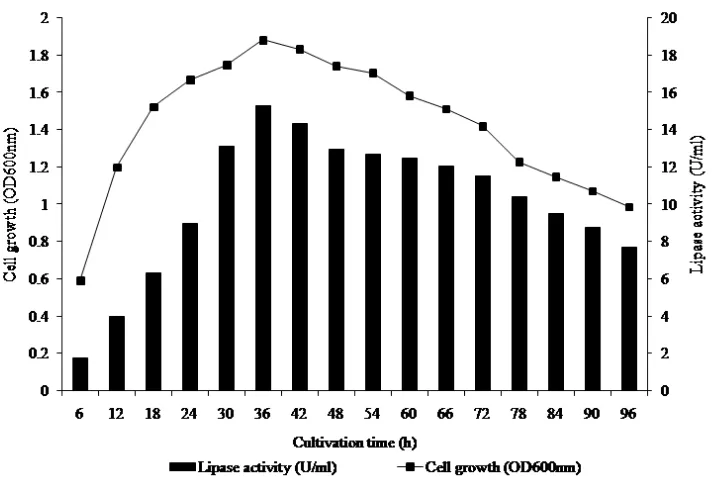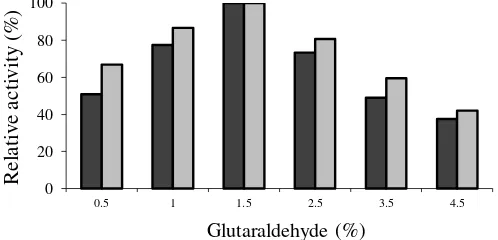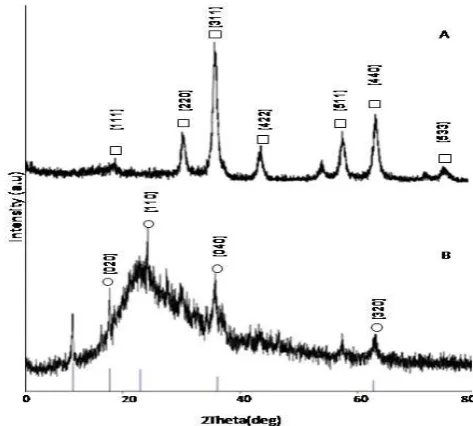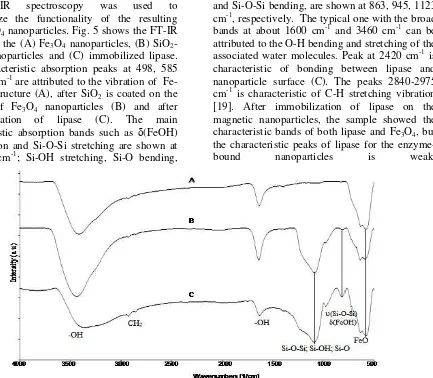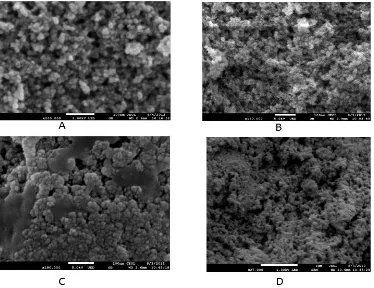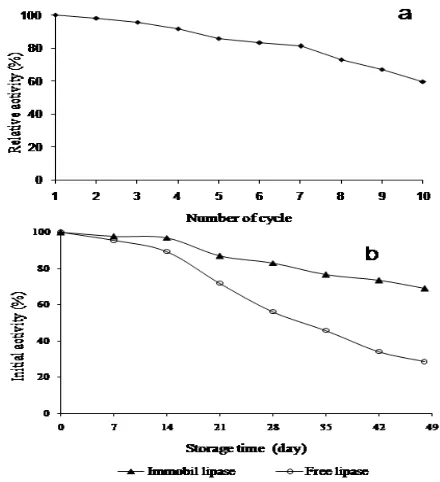RICE HUSK SILICA-COATED MAGNETIC PARTICLES AS A LOW COST SUPPORT
MATERIAL FOR CRUDE
Pseudomonas aeruginosa
LIPASE IMMOBILIZATION
Noor Hindryawati1* 1
Faculty of Mathematic and Natural Sciences, Mulawarman University, Gunung Kelua, 75113 Samarinda, East Kalimantan, Indonesia
*Corresponding author. Tel.: +62 5246646998 E-mail address: [email protected]
ABSTRACT
In this research, lipase produced from the bacteria Pseudomonas aeruginosa was immobilized on rice husk silica-coated Fe3O4 nanoparticles. The process included the following steps: preparation of magnetic ferosoferic oxide nanoparticles (NP), coating NP with silica from rice husk ash, activation with glutaraldehyde and covalent immobilization of lipase on the support. The synthesis of the nanoparticle was followed by characterization through FT-IR, XRD, and FE-SEM. The hydrolysis kinetics (using 4-Nitrophenyl palmitate as a substrate) of the immobilized lipase followed Michaelis-Menten model with a Vmax and a Km value of 4.0 mM.s-1 and 0.63 mM, respectively. The immobilized lipase showed better tolerance to extreme temperature and pH compared to free lipase. About 60% of enzyme remained immobilized after ten cycles of reuse and 68.13% of it were stable until 49 days. Thus the silica-coated Fe3O4 nanoparticles appeared to be a potential support material for lipase immobilization applications.
Keywords: Core-shell magnetic nanoparticles; Pseudomonas aeruginosa; immobilized lipase; rice-husk silica.
INTRODUCTION
In the field of biotechnology, lipases (EC 3.1.1.3) have got vast applications in biocatalysis. They belong to serine hydrolases and can catalyze both the hydrolysis of fats/oils and the biosynthesis of esters of glycerol or other alcohol with long chain fatty acids. Their use in the oleo chemical industry for the modification of fats and oils is particularly attractive [1]. The catalytic application of lipase is a clean technology due to its non-toxic and environment friendly nature. Much attention to be paid to overcome som e problems such as high cost of enzymes, inhibition by methanol, and exhaustion of lipase activity, which may add to the global effort on implementation of the enzymatic biodiesel production in industrial scale in the near future [3].
Several approaches can be applied to improve the enzyme stability. Most important approaches include: enzyme modification and enzyme immobilization. In the second approach, the e n z y m e molecules are attached onto/incorporated into larger structures through simple adsorption, covalent binding, or encapsulation [4, 5]. Enzyme modification means the change of enzyme structure by means of covalent reactions. A functional group or polymer can be added on the surface of an enzyme molecule to change its surface properties that may improve its stability.
Recently, enzymes are being immobilized on nanostructured materials to improve their catalytic efficacy as high surface-area/volume ratios of nanoparticles can effectively improve enzyme loading [6, 7]. However, there are some limitations in the recovery of nanomaterials immobilized enzyme. U se of magnetic nanoparticles can help overcome this problem. The magnetic nanoparticle-loaded enzymes can easily be recovered by applying magnetic field. This may minimize operational cost and improve the purity of products [8].
This work aimed to demonstrate the potential of using low cost support material in lipase immobilization. Rice husk ash is an abundant waste with high silica content having a promising application as support material. Silica is an amorphous inorganic polymer composed of silanol groups (Si-OH) distributed on its surface, making silica as hydrophilic support. In this study, surface modification was done using glutaraldehyde as a crosslinker for immobilization of enzymes in which the amino group of enzyme was expected to form a Schiff base with the glutarldehyde. Firstly, magnetic microspheres coated with SiOx were synthesized. Secondly, glutarldehyde was introduced onto Fe3O4/SiOx surface to prepare macromolecule initiator to make enzyme more comfortable in a new environment. Then Pseudomonas aureginosa
62 Kimia FMIPA Unmul acid, iron(II) chloride tetrahydrate, iron (III) chloride hexahydrate, 2-propanol, ethanol, methanol, acetone, ammonium sulfate, magnesium sulfate, glucose, calcium chloride, sodium dihydrogen phosphate, potassium phosphate, glutaraldehyde, ammonia, gum arabic, tris-HCl buffer, phosphate buffer, acetone, and hexane were obtained from Merck. Pseudomonas a eruginosa ATCC315442 MBL USA was supplied by Lonza Bioreseach
Synthesis of rice husk silica-coated Fe3O4
Preparation of rice husk silica
Rice husk was cleaned to eliminate stems, neutralized with distilled water and rinsed with deionized water. Furthermore, clean ash was dried in an oven at 100 C for 2 h. Sodium silicate was prepared by mixing 10 g rice husk ash with 80 ml of 3 N NaOH into a plastic container with stirring for 3 h at 90 C. The mixture was suction filtered to obtain sodium silicate.
2.2.2 Preparation of iron oxide magnetic nanoparticles.
Magnetic nanoparticles were prepared by co-precipitating Fe2+ and Fe3+ ion in NH4OH NH4OH added drop wise into the solution. During the additional of NH4OH, the solution changed color from the original orange to dark brown and then to black. The solution was heated at 80 C for 30 min, the precipitates were filtered and washed several times with distilled water and
ethanol, and dried under vacuum at room temperature.
Silica coating of magnetic nanoparticles
Coating of the magnetic nanoparticle was molar ratio of Fe) under magnetic stirring. After 4 h the solution was washed 3 times with water by magnetic decantation and adjusted to original volume with distilled water. Then 2 ml of magnetic solution was ultrasonically dispersed in absolute ethanol, 120 l sodium silicate solution (from rice husk ash) was added to the ethanol solution under mechanical stirring. After 4 h, 4 ml water, 1.4 ml NH4OH and 50 l sodium silicate were consecutively added to the reaction. The hydrolysis of sodium silicate was carried out under mechanical stirring for 12 h; the final product was washed with water.
Microbial lipase production
The bacterial strain Pseudomonas
aeruginosa was used for lipase production. About
2% v/v of the seed culture was used to inoculate several 250 ml Erlenmeyer flasks, each containing 150 ml of a medium composed of (g/L): 1% spectrophotometer and the optical density were converted to colony forming units (CFU). After incubation, the contents of each flask were centrifuged at 12,000 rpm at 4 C for 15 min and the supernatant used as crude lipase.
Immobilization of lipase
reaction, the unbounded enzyme was removed under a magnetic field, and the precipitates were removed and washed three times with phosphate buffer (50 mM, pH 7.5).
Enzyme assay
The activity of free and immobilized
Pseudomonas aeruginosa lipase was determined
by spectrophotometric assay using 4-nitrophenyl palmitate (pNPP) as substrate. The substrate solution was prepared by mixing one volume of a solution of pNPP (5 mM) with 9 volumes of buffer (0.1 mM Tris-HCl, pH 8.0) containing 0.4% (w/v) triton X-100 and 0.1% (w/v) gum arabic. Then, 100 L of the free and immobilized lipase was added separately to 3.4 ml of substrate solution. After 5 min of incubation, lipase activity was measured at 410 nm. One unit of activity was defined as the amount of enzyme that released 1 mol of pNP per min. Thermal and pH stability was evaluated by measuring the residual activity after 30 min incubation of the enzyme at specified temperature and pH. Kinetic parameters of free and immobilized enzyme were determined in the concentration range of 0.1–0.5 mM pNPP.
Characterization
The size and morphology of magnetic nanoparticles was observed by FE-SEM (JSM-7800F). XRD measurements were recorded on a RigakuD/max-3B X-ray diffractometer (Tokyo Japan) employing Cu K diffractometer. The KBr pellet technique was used for determining the FT-IR (PerkinElmer Spectrum 100 FT-IR Spectrometer) spectra of magnetic nanoparticles, and lipase bound nanoparticles.
RESULTS AND DISCUSSION Lipase production
Pseudomonas aeruginosa was used for
lipase production in batch culture over a period of 96 h at temperature 37 C, pH 7.5, and agitation at 180 rpm. The maximum lipase activity was obtained at 36 h of incubation while the activity decreased after 42 h. Under the optimal culture conditions, the typical lipase activity of supernatant of the culture media was measured to
be 15.3 U˖ml-1 (Fig. 1).
Fig. 1. Effect of culture time on lipase production by Pseudomonas aeruginosa. Preparation of support material
Preparation of the silica support material from rice husk ash as sodium silicate took place through the chemical reaction as shown in Eq. (1).
O
H
SiO
Na
2NaOH
SiO
2
2 3
2 (1)64 Kimia FMIPA Unmul surface-modified magnetic nanoparticles. The specific interactions between magnetic NP and silica could be intermolecular covalent bond formation (Si-O-Fe), electrostatic interaction between negatively charged Si-O terminal and positively charged groups on the particle surface, or hydrogen-bonds between hydration layer of silanol groups and the particles surface [11]. It might be a suitable approach for the interaction of magnetic NP and silica by magnetic dipole attraction through the silica shell [10].
Immobilization of lipase
Rice husk silica-coated Fe3O4 nanoparticles was used for lipase immobilization by covalent crosslinking between glutaraldehyde and an amino group of lipase at room temperature.
Furthermore, the effect of various concentrations of glutaraldehyde (0.5; 1; 1.5; 2; 3; 4; 5 wt.%) on the surface activation of support material was investigated. Fig. 2 shows the optimum concentration of gluteraldehyde for immobilization to be 1.5%. Increasing the amount of glutaraldehyde above this value reduced the lipase activity. This result is in full agreement with that reported by He et al. [11] and Lee et al. [12]. Glutaraldehyde facilitates the binding of the enzyme to the support via its aldehyde group and the amino group of lipase. Glutaraldehyde can influence the activity of lipase and can cause denaturation of enzymes due to attachment of excess gluteraldehyde with other amino groups of the enzyme at or near the active site. Excessive amount of glutaraldehyde may also undergo self-cross-linking, which might have a steric effect on lipase immobilization [9].
Fig. 2. Effect of glutaraldehyde concentration on the immobilization of lipase.
Effect of incubation time (1-6 h) on the activity of immobilized lipase was also studied. As shown in Fig. 3, the relative activity changed with incubation time, and the highest activity was obtained at 3 h. Thus, the optimal incubation time was considered to be about 3 h. The binding of decrease the lipase activity because the active site
of lipase could get involved in covalent bond formation with the support [9].
In this part, different amounts of the crude lipase (50–450 U/mL) were used for immobilization on 100 mg of RHS-coated Fe3O4 nanoparticles. As shown in Fig. 3b, the amount of immobilized lipase increased with increasing the initial amount of lipase and the relative activity reached a maximum value at 350 U/ml. It seems that the over loading of enzyme molecules on RHS-Fe3O4 causes some unfavorable protein– protein interactions that, subsequently, reduces the enzyme activity [6].
Fig. 3. (a) Effect of incubation time, and (b) lipase loading on the immobilize process.
Physicochemical properties of nanomaterials and immobilized lipase
X-ray diffraction (XRD) was used to determine the crystal structure of the magnetic nanoparticles obtained by coprecipitation method, which are shown in Fig. 4A. There are many different possible iron oxide structures such as magnetite (Fe3O4), hematite (-Fe3O4), maghemite (-Fe3O4). The characteristic peaks appeared at 18.59 (111), 30.38 (220), 35.62 (311), 53.85 (422), 57.30 (511), 62.97 (440), 72.62 (533) [14, 15]. The d spacing calculated from the pattern is close to those of magnetite. Becauses of the presence of non-equivalent iron cations in two valence states Fe2+ and Fe3+, Fe3O4 demonstrates interesting properties in the crystal structure [16]. This nanoparticle has small size and large surface area and easy to be recovered because of the nanoparticles has a large magnetic susceptibility.
Magnetite-silica core shell structures are shown in Fig. 4B. The characteristic peaks appeared at 17.78 (020), 22.92 (110) (400) (220), 36.19 (040) (002) (332), 62.77 (320) (152) (651). The broad peak at high angels (4B) at 2 between 20 until 30 are attributing to the peak of the siliceous material. The d spacing calculated from the pattern is close to those of iron silicate, ferrosilite and skiagite, syn. According to Lei et al. [17], Fe3O4/SiOx has a large saturation magnetization and it can be separated from the reaction medium rapidly and easily by applying magnetic field. Silica coating renders the sol anionic within the working pH range and is comfortable for biomolecules. Silica could coat the surface of magnetite NP with a strong affinity for iron oxide [18]. Furthermore, mesoporous silica shell is capable for the derivation of numerous functional groups.
66 Kimia FMIPA Unmul FT-IR spectroscopy was used to
characterize the functionality of the resulting SiO2/Fe3O4 nanoparticles. Fig. 5 shows the FT-IR spectra of the (A) Fe3O4 nanoparticles, (B) SiO2-Fe3O4 nanoparticles and (C) immobilized lipase. The characteristic absorption peaks at 498, 585 and 586 cm-1 are attributed to the vibration of Fe-O bond structure (A), after SiFe-O2 is coated on the surface of Fe3O4 nanoparticles (B) and after immobilization of lipase (C). The main characteristic absorption bands such as (FeOH) deformation and Si-O-Si stretching are shown at 803-805 cm-1; Si-OH stretching, Si-O bending,
and Si-O-Si bending, are shown at 863, 945, 1123 cm-1, respectively. The typical one with the broad bands at about 1600 cm-1 and 3460 cm-1 can be attributed to the O-H bending and stretching of the associated water molecules. Peak at 2420 cm-1 is characteristic of bonding between lipase and nanoparticle surface (C). The peaks 2840-2975 cm-1 is characteristic of C-H stretching vibration [19]. After immobilization of lipase on the magnetic nanoparticles, the sample showed the characteristic bands of both lipase and Fe3O4, but the characteristic peaks of lipase for the
enzyme-bound nanoparticles is weak.
Fig. 5. FT-IR spectra of modified nanoparticles (a) Fe3O4, (b) silica-magnetic nanoparticles, (c) immobilized lipase
No additional band in the spectra of the immobilized lipase was observed, since the covalent bond between the lipase and carrier is of the same nature as in typical protein bonds. Glutaraldehyde is a functionally reactive compound capable of reacting with the amine groups of enzyme and the support, resulting in amide bonds similar to those present in free lipase. Therefore, lipase is indeed successfully bound to the surface of the magnetic nanoparticles.
The morphology of pure magnetic nanoparticle appeared to be spherical (Fig. 6a) with smooth surface. The core-shell nanoparticles were found to be natural [15] and the pore size measured as 4.5 nm. From FE-SEM result, Fe3O4 nanoparticles shell in spherical-magnet was calculated to be around 30-120 nm. Coating Fe3O4 nanoparticle shells with amorphous silica would result in smooth porous materials (Fe3O4-SiO2), thereby increasing surface area (Fig. 6b). Furthermore, Fig. 6c shows the cluster of crosslinking agent glutaraldehyde at the surface of
porous material interacting with lipase, and the immobilized lipase seemed to be fully bound on the surface of that porous nanomaterial (Fig. 6d).
Kinetics of immobilized lipase
Fig.6. FE-SEM image of (a) Fe3O4, (b) silica-magnetic nanoparticles, (c) silica magnetic-glutaraldehyde, (d)
immobilized lipase
The activities of free and immobilized lipase were determined at temperature ranging from 30 C to 70 C at a constant pH values of of 8.0 and 8.5, respectively. The results are shown in Fig. 7(b); the optimal temperature of IPAL and free lipase are 40 and 50 C, respectively. The
activity of free lipase was almost completely lost at 60 C whereas IPAL showed broader range of temperature tolerance. Thus the immobilized lipase was less susceptible to changes of temperature than free lipase when the temperature ranged from 45 to 60 C.
Fig. 7. (a) pH profile of free and immobilized lipase, (b)Temperature profile of free and immobilized lipase
To study the effect of lipase immobilization on rice husk silica-coated FeO4 nanoparticles, kinetic constants (Km and Vmax) of free and immobilized lipase were determined. The results are demonstrated in Fig. 8, the Km and Vmax were 1.8 mM and 9.3 mM.s-1, respectively for
68 Kimia FMIPA Unmul According to Tran et al. [15] and Chen et al. [21]
the structure of enzymes could be rigidified on the surface of support magnetic nanoparticles due to covalent binding, thus blocking the active site of
lipase that would decrease lipase activity. Moreover, the immobilization process may hamper the orientation of the enzyme bound on the support.
Fig. 8. Lineweaver-Burk plots for the hydrolysis of p-nitrophenylpalmitate by (■) free and () immobilized lipase
Reusability and thermal stability
One of the pretty important aspects of application of immobilized lipase is its reusability, especially in the industrial sector. To study the reusability, the immobilized lipase was washed with phosphate buffer (0.1 M, pH 7.0) after one run of catalysis and reintroduced into a fresh p-NPP solution at 37 C and activity assayed. This process was repeated several cycles. The variation of the relative activity of IPAL after multiple-reuse is shown in Fig. 9(a). It was observed that after the 5th reuse the residual activity was still maintained at about 60% of the initial activity. Additionally, IPAL showed good stability and reusability. The gradual decrease of activity was considered as the denaturation and/ or partial leakage of enzyme from support during the process of reuse [22].
Free and immobilized lipase was kept at 4 C under the same conditions for 49 days and their activities were monitored every 7 days (Fig. 9b). At the same temperature, the activity of immobilized lipase decreased more slowly than free lipase [23]. After 49 days of storage, immobilized lipase retained about 68.13% of the initial activity but free lipase retained only 23.16%. Data indicated that the immobilized
lipase can be stored and used for a long time during the experiment than the free lipase.
CONCLUSIONS
This article described a cost-effective method for the covalent immobilization of lipase on the surface of rice husk silica-coated Fe3O4 nanoparticles. The FE-SEM image showed that the silica-coated Fe3O4 nanoparticles shell was spherical and XRD pattern proved that silica-coated magnetic nanoparticles did not change the characteristic of Fe3O4. The FT-IR spectrum was used for confirming the immobilization of lipase into nanoparticles. The outcome confirmed the substantial improvement of thermal, pH and storage stability of lipase upon immobilization. Furthermore, kinetic study demonstrated a well maintenance of activity of immobilized lipase. The hydrolysis kinetics (using 4-Nitrophenyl palmitate as a substrate) of the immobilized lipase followed Michaelis-Menten model with a maximum reaction velocity and a Michaelis constant of 4.0 mM.s-1 and 0.63 mM, respectively. The enzyme recovery study represented about 60% of initial activity after five cycles of reuse and storage stability demonstrated 68.13% activity until 49 days of storage. The studied nanoparticles appeared to be a potential material for lipase immobilization.
REFERENCES
[1] Sangeetha R, Arulpandi I, Geetha A. Bacterial Lipases as Potential Industrial Biocatalysts: An Overview. Research J. Microbiol., 6, 1-24(2011).
[2] Lorenzo M D. Improvement of lipase stability in the presence of commercial triglycerides. Ph. D. Thesis, Università di Napoli Federico II., Italy (2007).
[3] Yapasan E. Partial purification and characterization of lipase enzyme from a
Pseudomonas strain. Master Thesis, Izmir Institute of Technology., Turkey (2008). [4] Mikkelsen, Corton. Bioanalytical
Chemistry, Jhon Wiley & Sons,Inc, (2004). [5] Anming W, Cheng Z, Hua W, Shubao, S,
Jianyue X, Pingkai, Q., Covalent assembly of penicillin acylase in mesoporous silica based on macromolecular crowding theory.
Chin. J. Chem. Eng., 15(6), 788-790 (2012).
[6] Ranjbakhsh E, Bordbar AK, Abbasi M, Khosropour AR, Shams E. Enhancement of stability and catalytic activity of immobilized lipase on silica-coated modified magnetite nanoparticles. Chem. Eng. J., 179, 272-276 (2012).
[7] Anming W, Hua W, Cheng Z, Zhiqiang D,
Shemia Z, Shubao, S. Ag-induced efficient immobilization of papain on silica spheres.
Chin. J. Chem. Eng., 16(6), 788-790 (2007).
[8] Wang X, Dou P, Zhao P, Zhao C, Ding Y, Xu P. Immobilization of lipases onto magnetic Fe3O4 nanoparticles for application in biodiesel production.
ChemSusChem., 2, 947-950 (2009).
[9] Xie W, Ma N. Immobilized lipase on Fe3O4 nanoparticles as biocatalys for biodiesel production. Energy & Fuel, 23(3), 1347– 1353 (2009).
[10] Sun Y, Duan L, Guo Z, Duan M Y, Ma M, Xu L, Zhang Y, Gu N. An improved way to prepare superparamagnetic magnetite-silica core-shell nanoparticles for possible biological application. J.Magn. Magn. Mater., 285, 65-70 (2005).
[11] He F, Zhuo R X, Liu L J, Jin D B, Feng J, Wang X L. Immobilization lipase on porous silica beads: preparation and application for enzymatic ring-opening polymerization of cyclic phosphate. React. Funct. Polym., 47, 153-158 (2001).
[12] Lee D H, Park C H, Yeo J M, Kim S W. Lipase immobilization on silica gel using cross-linking method. J. Ind. Eng., 13(5), 777-782 (2006).
[13] Zeng L, Luo K, Gong Y. Preparation and characterization of dendritic composite magnetic particles as a novel enzyme immobilization carrier. J. Mol. Catal. B:
Enzym., 38, 24-30 (2006).
[14] Andrade A L, Souza D M, Pereira M C, Fabris J D, Domingues R Z. Synthesis and Characterization of magnetic nanoparticles coated with silica through a sol-gel approach. Ceramica. 55, 420-424 (2009). [15] Tran D, Chen C, Chang J. Immobilization
of Burkholderia sp. lipase on a ferric silica nanocomposite for biodiesel production. J. Biotechnol., 158, 112-119 (2012).
[16] Ranganath K V S, Glorius F. Superparamagnetic nanoparticles for asymmetric catalysis-a perfect match.
Catal. Sci. Technol., 1, 13-22(2011). [17] Lei L, Liu X, Li Y, Cui Y, Yang Y, Qin G
Study on synthesis of poly(GMA)-grafted Fe3O4/SiOx magnetic nanoparticles using atom transfer radical polymerization and their application for lipase immobilization.
Mater. Chem. Physics., 125,
866-871(2011).
70 Kimia FMIPA Unmul nanoparticles: synthesis, stabilization,
functionalization, characterization, and applications. J. Iran. Chem. Soc., 7(1), 1-37(2010).
[19] Huacong Z, Wei L, Qinghui S, Hongshuai G, Peng X, Fuli D, Huizhou L. Immobilization of pinicilin G acylase on magnetic nanoparticles modified by ionic liquids. Chin. J. Chem. Eng., 20(1), 146-151 (2012).
[20] Lien Y, Wu T. Preparation and characterization of thermosensitive polymers grafted onto silica-coated iron oxide nanoparticles. J Colloid Interf. Sci., 326, 517-521(2008).
[21] Chen G, Kuo C, Chen C, Yu C, Hieh C, Liu Y. Effect of membranes with various hydrophobic/hydrophilic properties on lipase immobilized activity and stability. J.
Biosci. Bioeng., 113, 166-172(2012).
[22] Chaubey A, Parshad R, Taneja S C, Qazi G N. Arthrobacter sp. lipase immobilization on magnetic sol–gel composite supports for enantioselectivity improvement. Process
Biochem., 44, 154-160(2009).
